Briard is a French Shepherd Dog with long hair all over the body and stylish shaggy bangs on the forehead that hide the eyes. Among breeders, it is appreciated for a sharp mind, liveliness of character, and independence in decision-making.
Briard is an energetic dog with a bright, memorable image and a truly strong character. Having made a reputation for his outstanding talent for shepherding, the shaggy intellectual has always been distinguished by an amazing love of life, developed intuition, and the ability to win over a person. Getting along with a briard means not trying to educate him as a performer of his momentary whims, because this stylish handsome man is ready to serve, but not to serve. In addition, you need to take into account the possessive habits of the breed: the briard is your dog, which will not leave room in the heart for another furry.
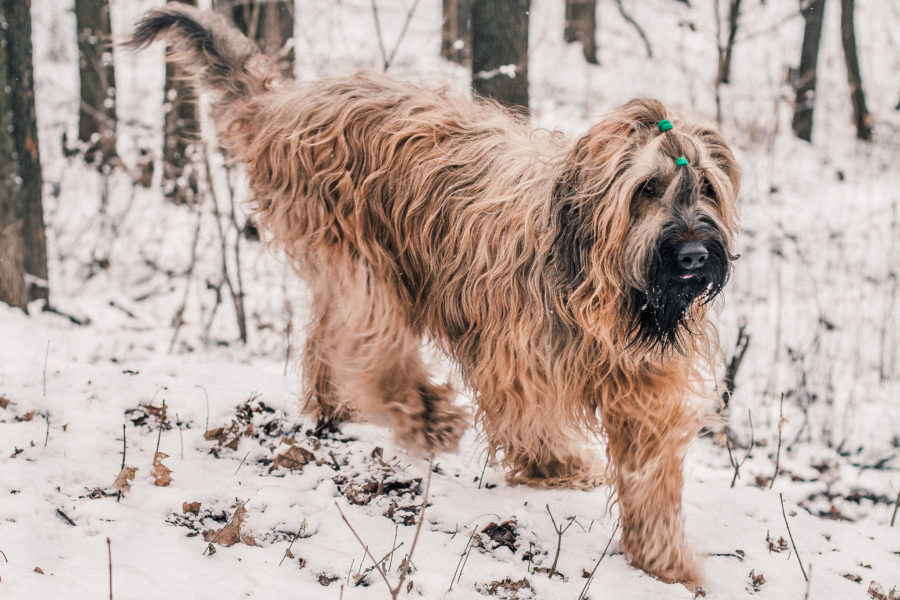
Already in the XII century, French farmers were in close contact with the ancestors of the Briards, who were attracted to graze sheep flocks. True, in those days, representatives of this canine family were called Briar Sheepdogs – after the name of the province of Bree, in which they were allegedly bred. Large, massive animals were valued by peasants mainly for independence and the ability to lead a herd without looking back at the owner. For example, a properly trained dog could single-handedly cope with a sheep herd, driving it out in the morning to graze, and in the evening collecting livestock and seeing it off the field.
The first more or less truthful description of the appearance and character of the Briar Sheepdogs was compiled in 1809 by Abbot Roney. In his agricultural treatise, the clergyman described dogs as excellent shepherds and tireless defenders of farm property. By 1885, the Briards’ performance and intelligence were so publicized that the animals were granted the status of an independent breed, and two years later a separate standard of appearance was approved for them. But the real popularity overtook the shepherd dogs during the Second World War. In the conditions of a protracted war, these shaggy stalwarts have established themselves as a cheap draft force, so for several years they took out the wounded from the field, and also delivered shells to the trenches, which almost disappeared as a breed.
In 1924, French specialists set out to restore the Briard population and founded the first shepherd club. Since that time, animals have ceased to be considered exclusively as peasant dogs, thanks to which they moved to a more elite “caste” of companions and athletes. In the middle of the 20th century, the Briards began to expand the boundaries of their own popularity, emigrating to the rest of Europe and North America. However, the New World was not interested in the breed for unknown reasons, so the overwhelming majority of its representatives continued to live in the countries of Western Europe. In the Soviet Union, they learned about the briards with some delay, in the late 80s, but at an accelerated pace they made up for a lost time. In particular, already in 1991, domestic breeders with might and main boasted to foreign colleagues of the first puppies “made in Russia”.
Famous owners of briards:
- Napoleon Bonaparte;
- Charlemagne;
- Alexander Maslyakov.
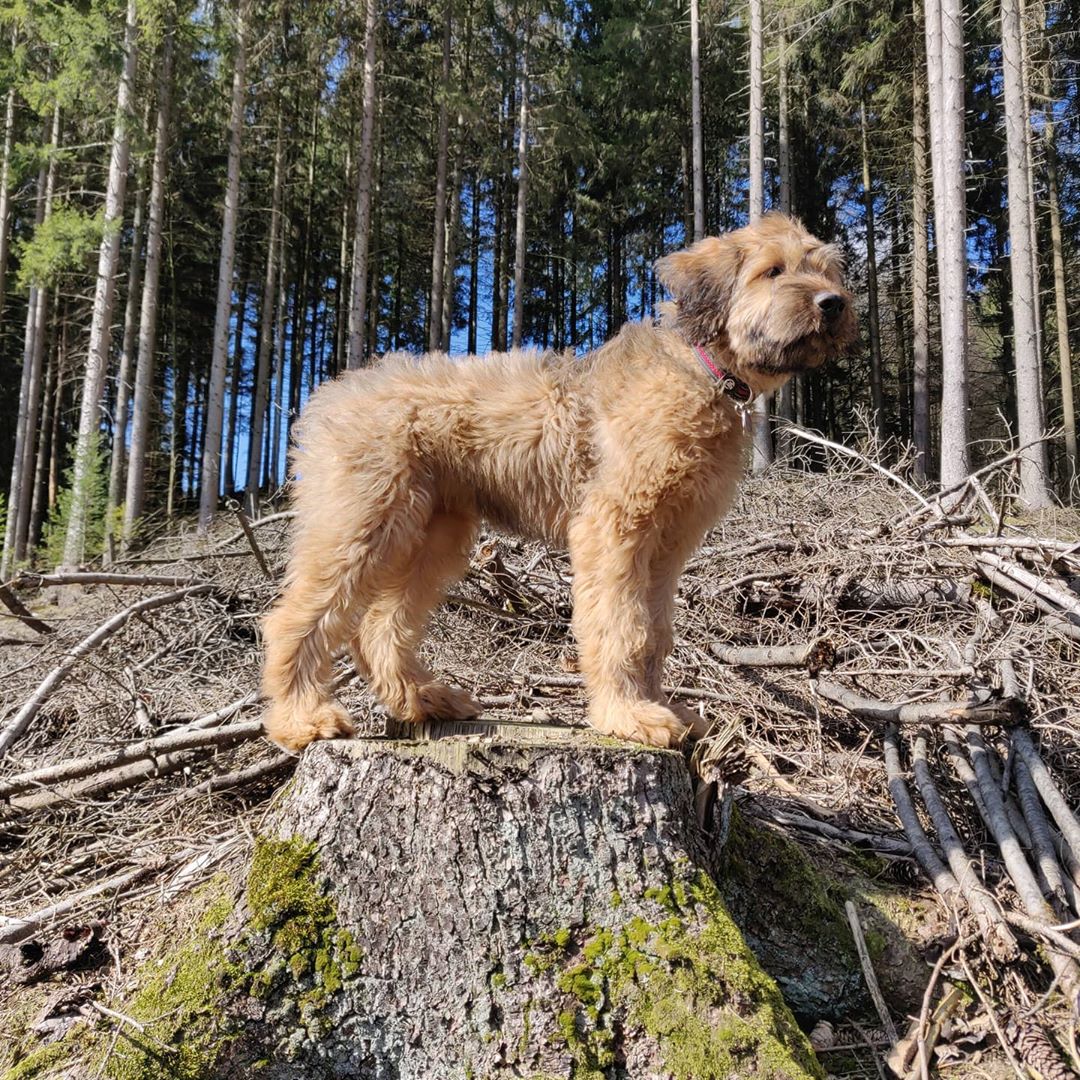
Briard is a charming mess with hipster bangs, wrapped in a long, shaggy “fur coat”. The gender type in the representatives of this breed is pronounced, therefore, Briard females are noticeably smaller (average height – 56-64 cm) and more graceful than males. At the same time, the boys also do not differ in excessive baggy and are quite graceful.
The deceptive negligence and rusticity of the Briards are in fact the result of many years of work of breeding specialists. What is there! French breeders tremble over their wards, as over a real living rarity, in an attempt to preserve the original appearance of the dogs and by all means to avoid the slightest change in their image. Perhaps that is why in the breed standard more space is given to the listing of possible defects and defects of the Briar Sheepdogs than to the description of their exterior features.
The head of the briard is elongated, with a rounded forehead and a rather steep stop.
A purebred shepherd dog has a complete set of 42 snow-white, strong teeth. The standard bite type for the Briard breed is “scissors”.
The nose of the briard is straight, without hump or dip, and ends with a square black lobe.
The eyes are large, the dog’s dark eyes are set straight, not tilted. The steel color of the iris is permissible only for individuals with gray hair.
The ears of the Briar Shepherd Dogs have been cropped since ancient times, which is why the ear sheet took a standing position. Today the countries of the European Union have abandoned this procedure, so modern French briards have short, high-set ears and slightly close to the head. In Russia, cupping has not yet outlived its usefulness, but when acquiring a puppy, over whose ears the veterinarian has already worked, remember: it is better not to show such a briar at European exhibitions.
The neck is strong, the muscular neck of the briard resembles a truncated cone shape and smoothly grows into the shoulders.
The body of the dog is somewhat elongated, with a massive chest, straight back, and sloping, rounded croup.
Both the fore and hind legs of the briard are very strong, muscular, set strictly upright. Hock joint moderately angulated, not too low. Feet strong, catlike, with firm pads. The nails are black. A distinctive feature of the breed is double dewclaws on both hind legs.
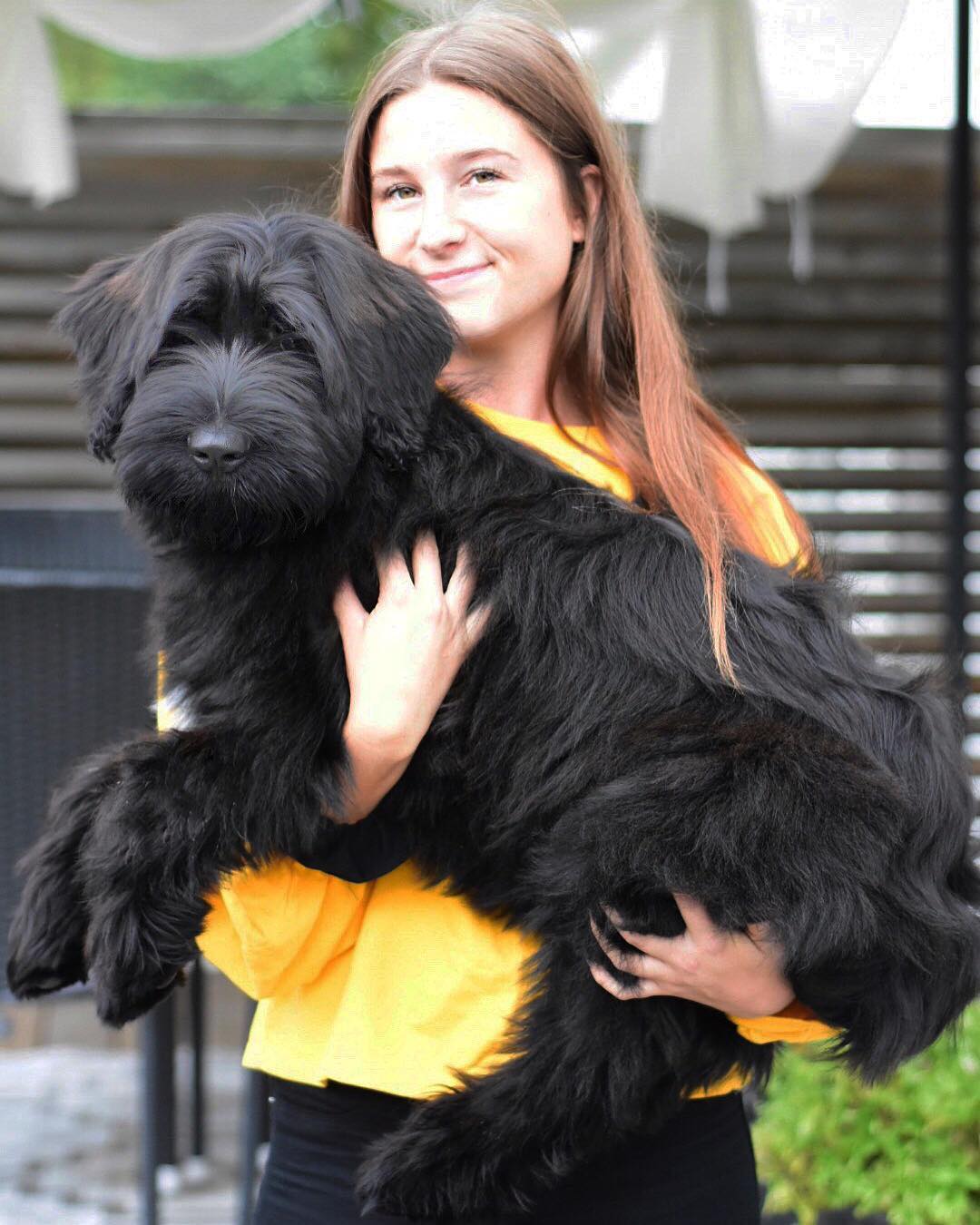
The tail of the briard is carried low, curving into a hook at the end.
The dry, long hair of a shepherd dog resembles goat hair in structure.
Briard can be of any solid color type except white, chocolate, and mahogany. At the same time, at exhibitions, preference is always given to darker individuals. It is acceptable if the hair on the dog’s legs is lighter in color than the hair on the rest of the body.
Disqualifying vices:
- Height is higher or lower than the stipulated standard by more than 2 cm.
- Brown or pink lobe.
- Strong overshot.
- Absence of any three teeth or two lower fourth premolars.
- The eyes are too light.
- Ears that are too low set with folds or fused cartilages.
- Unparallel hind legs.
- Tail upright or tail thrown over the back.
- White nails.
- Incomplete set of dewclaws or their complete absence.
- Hair length less than 7 cm, hair with a pronounced curl, too soft.
- The presence of white spots on the body and white hairs on the legs.
- Fawn with black color, the presence of a black “cloak” on the body of the shepherd.
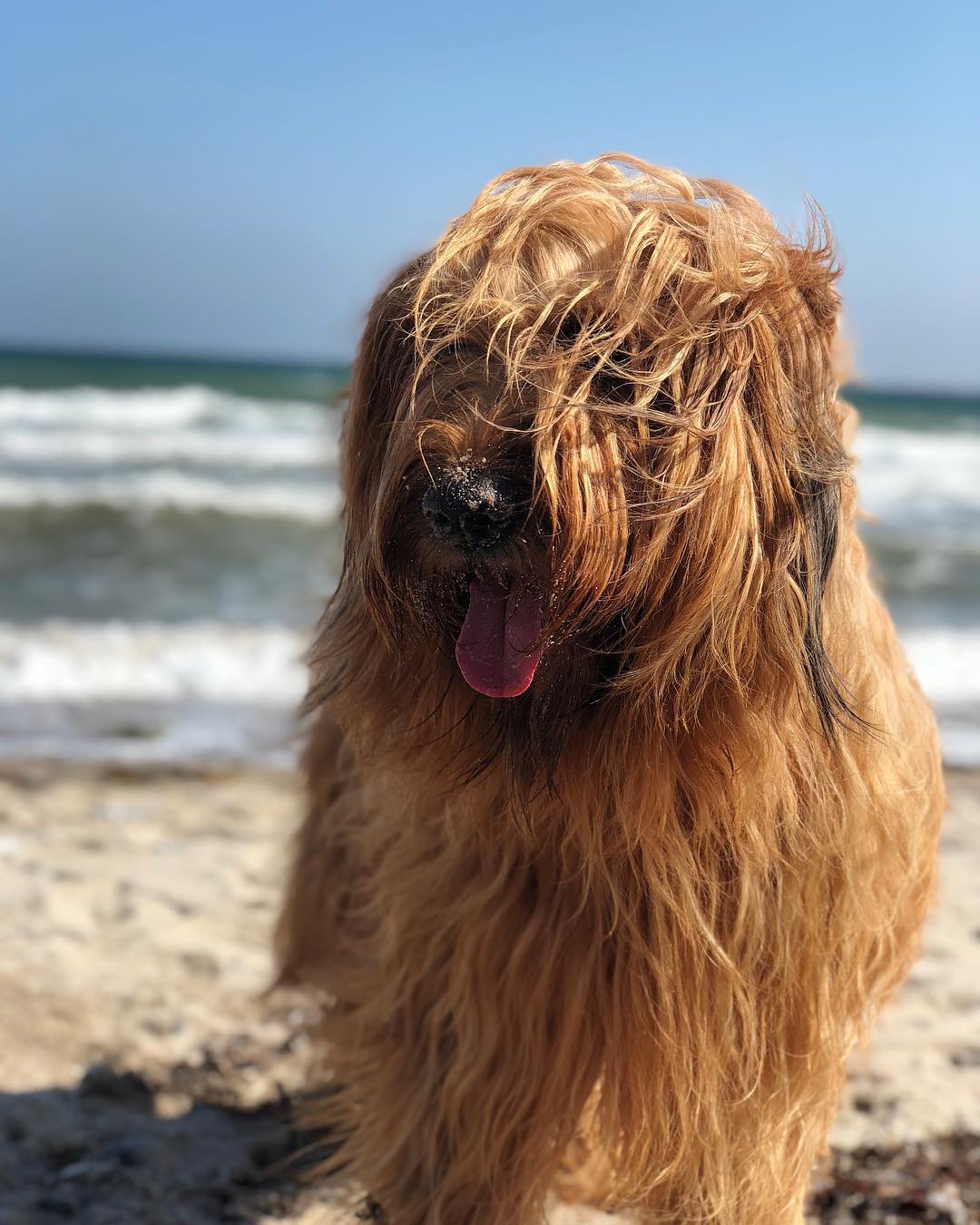
Briard is a difficult dog in every respect. On the one hand, it is a loyal pet, loving souls in its own master, and on the other hand, it is the greatest manipulator who will never agree to a secondary role in your life. The external charm of the Briards is something beyond description! Begging glances, flirtatious antics, facial expressions full of comic charm – these French rogues have in reserve a whole arsenal of various tricks that allow them to get what they want. By the way, it was on the overwhelming mimicry of the breed that most inexperienced owners burned because as soon as the briard realizes that his skillful pantomime amuses you, he will turn into a cunning and naughty darling.
Oddly enough, but the expressly authoritarian style in dealing with these shaggy pets does not work either. Briard categorically cannot stand it when they try to suppress his will or, even worse, start to urge him on. In the eyes of the dog, this behavior looks like a form of mockery, which she will never forgive you. Yes, the pet does not mind at all to be shown the right place, but this should not look like an infringement on his personal dignity, which is somewhat hypertrophied among the representatives of this breed.
Briards perfectly feel the mood of the owner and often copy his behavior, so if you are used to sorting things out with your family in a raised tone, do not be surprised that the shaggy “monsieur” will try to participate in them, that is, grumble and bark loudly. As for the intelligence of a dog, like a human, it requires constant development, so often load your pet with useful activities that require a certain ingenuity. For example, instruct Briard to bring you a cell phone whenever it rings, or teach him how to get the morning newspaper out of his mailbox.
If you are too lazy to engage in the intellectual education of a briard, get ready for the fact that he will develop his own “training course”, and you will rake the consequences of such exercises for a very long time. For example, Briar Sheepdogs do an excellent job of opening all kinds of lockers and retrieving their contents, and they are also always ready to measure their strength with other dogs or drive cats.
Briards are jealous and touchy. Take it for granted and do not provoke the animal for no reason. This “Frenchman” will forgive his owner a lot, but not the ostentatious love for some cat or pug. And by the way, even if you bring a second briard into the house, it will not improve the situation at all, since each of the dogs will try to draw the master’s attention to themselves. Are you ready to be torn 24 hours a day between two shaggy “hipsters”? Then go ahead! In communicating with strangers and unfamiliar people, briards are restrained, if not suspicious, so when you see one of these shaggy handsome guys on the street, do not rush to bang him on the head – suddenly he is in a bad mood today.
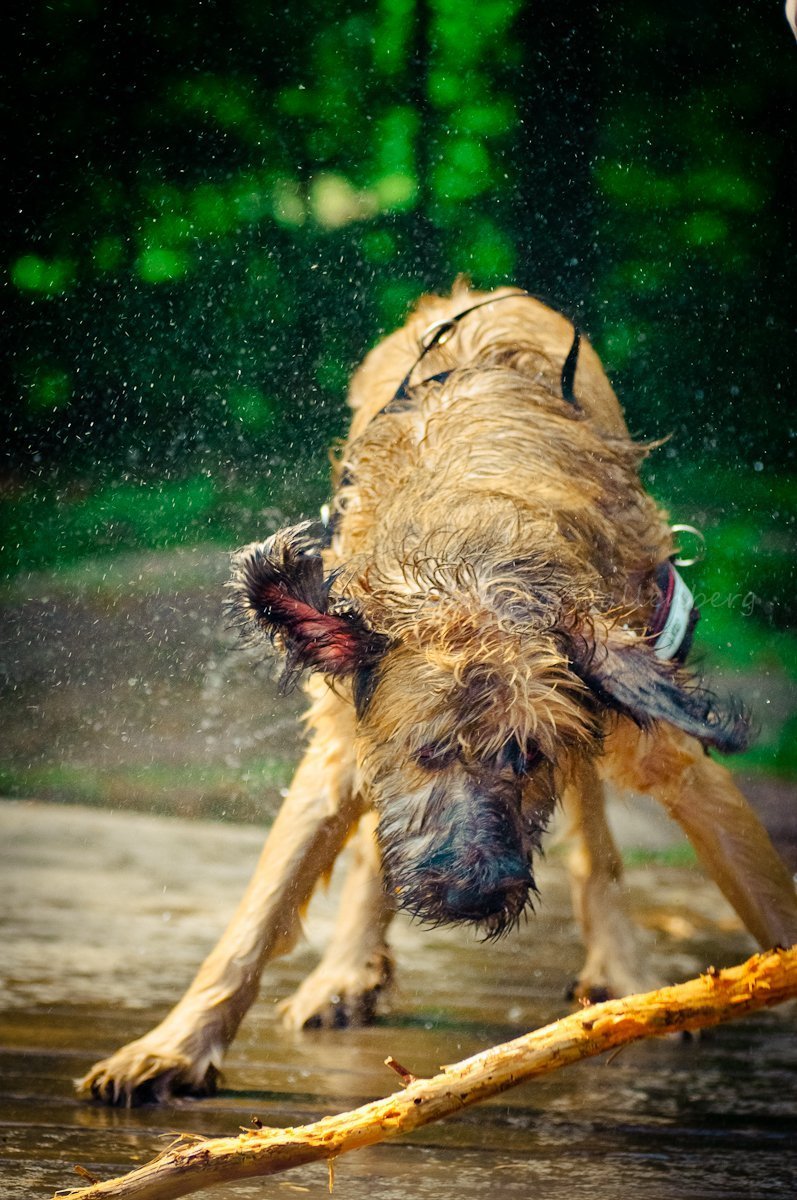
Briards are unusually memorable, understanding, but not devoid of stubbornness, students who need a special key. By the way, to apply to them punishments, especially physical ones, means only to worsen the matter and permanently lose their trust. In your heart, you can scold the shepherd as much as you like, but do not allow yourself to take out your irritation on it. Briard was not born to blindly obey orders. This is a thinking dog, with its own views on life in general and on training in particular. But if the pet has at least once performed the command as required by the rules, do not hesitate, he will not forget this and will easily repeat the “feat” even after 2-3 months.
The desire to dominate and take the place of the owner is completely normal for briards. And if the males immediately go ahead, asserting their own authority, then the females act by deception, coming up with ingenious strategies to bypass the rules. If you notice that it becomes difficult to cope with the dog, entrust its training to a professional – save your nerves and do not start the animal.
If we are talking about training courses, then with briards, OKD (General course of training) and UGS (Controlled city dog) are most often passed. In addition, shepherd dogs have a clear propensity for sports such as agility, freestyle, skijoring, and weight pulling. IPO (International Obedience System) course Briards also click like seeds, and, unlike most other breeds, these “French” can master new knowledge at any age. And of course, do not forget about the main qualification of the breed – a shepherd’s service, tests for which Briards usually pass with the highest score.
You can take a dog to the training ground from 6-7 months, and learning basic rules of behavior and simple commands are allowed to begin as early as 4 months of age. The best way to socialize your briard puppy is to walk the busy streets with it so that your little one is no longer afraid. Of course, it will not work to force a pet to love other dogs in this way, but it is quite possible to help him come to terms with the inevitability of their presence in his life. Briard owners are advised to wrap the leash in their hands and walk their charges in places of maximum concentration of dog lovers and their four-footed pupils.
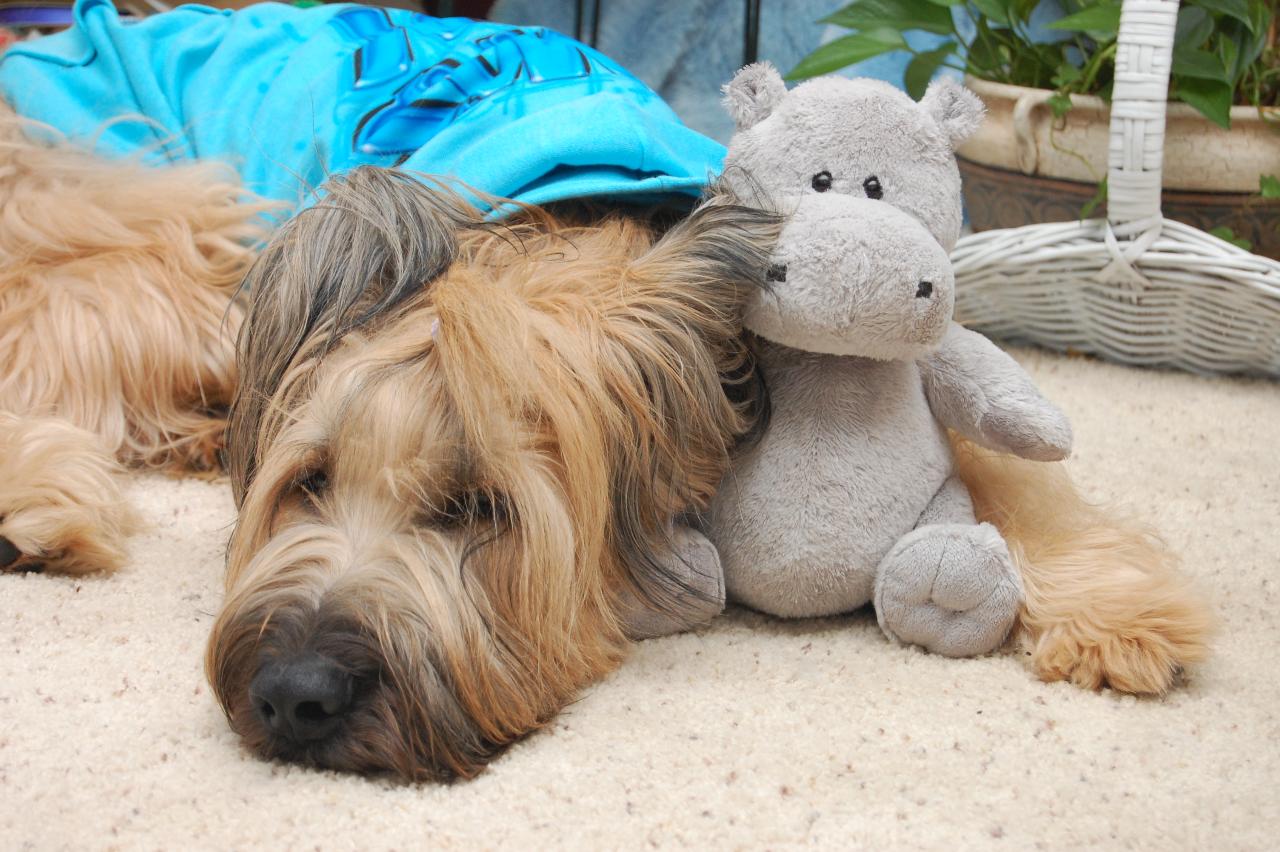
Despite the rather impressive dimensions, the briard is not a yard shepherd dog and it is contraindicated for him to live in a booth, especially in the cold season. The breed has a habit of mild French climate. For the summer, the animal can be moved to an aviary, where it will be quite comfortable. As for the apartment maintenance: everything is not as complicated as it seems at first glance. A properly raised briard does not rush headlong around the apartment and does not make a mess, which means it does not take up so much space. True, it costs longer to walk such a dog, and even better – to enroll it in some kind of training course, where it can run for its own pleasure.
Long, dry briar hair does not shed in the full sense of the word, it just forms tangles. But since it is not customary for dog owners to trim representatives of this breed, they will have to be combed often and thoroughly. First, the wool is worked with a rare comb to remove the debris entangled in it and partially break the felted areas, after which a massage comb or comb with frequent teeth is passed through the “fur coat”. If the moment is missed, and the tangles did appear, try to disassemble them. Arm yourself with a collar cutter only as a last resort, when the matted wool no longer lends itself to unraveling.
Important: brushing the briar dry can ruin the structure of its coat and expose the dog to additional stress. Use a conditioner designed to facilitate this procedure.
The dog’s mustache and beard are also regularly combed out. In addition, you will have to constantly monitor their cleanliness, as they invariably get dirty during feeding. Shepherd dogs do not cut stylish bangs on the head, but if the hair grows too intensively, it is slightly milled (thinned out) with hairdressing scissors and pulled together with an elastic band. However, if you keep a dog for the soul and are not going to storm exhibitions, the hair can be shortened a little. The main thing is that after a haircut in the dog, a briard should be guessed, and not an overgrown lapdog. It is necessary to cut the hair between the fingers, which quickly gets dirty, knots into lumps, interfering with the animal when walking.

Frequent bathing of briards is not recommended, as it leads to uncontrolled dumping of the undercoat, so if your ward lives in the house, periodically sitting in the yard aviary, wash him once every couple of months. You can bathe capricious “townspeople” living in apartments more often, about once or twice a month. By the way, at the same time get ready to smell a specific smell, as wet briar hair gives off a lot of sheepskin. As for the show specimens, it is better to wash them not on the eve of the event, but at least a week before it.
Do not forget about high-quality cosmetics, without which the wool of these charismatic “monsters” will not be so airy and shiny. This means that from time to time you will have to unfasten not the smallest amounts for shampoo, conditioner, cream to facilitate combing and other grooming lotions that give the dog’s hair gloss and the necessary softness.
The eyes and ears of briards do not need specific care. Just keep them clean using a standard arsenal of products: ear lotion, cotton swabs, chamomile infusion to relieve minor eye inflammations. An exception is dogs with an uncropped hanging ear canopy, which are prone to otitis media. For such individuals, standard cleaning will not be enough, therefore, to improve ventilation, they will have to thin out the hair in the ear canal. The claws of Briary Shepherd Dogs are sheared as they grow, with a guillotine-type claw cutter, with which there is less chance of injuring the dog.
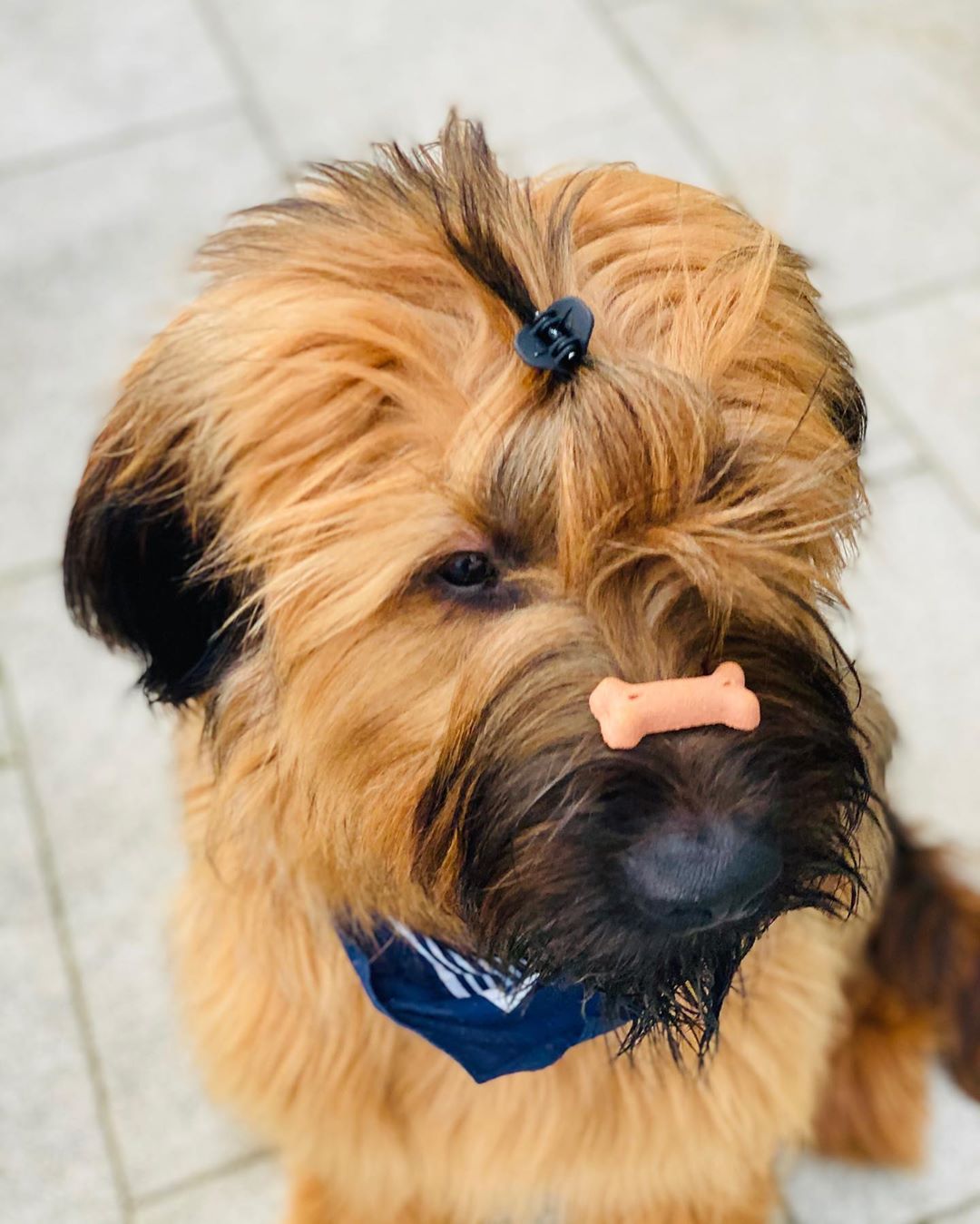 ,
,
Briards are picky about food and do not need delicacies. A healthy dog that gets the right workload is ready to be content with stringy meat scraps and offal mixed with buckwheat, oatmeal, or rice porridge. Saltwater fish of the cod family is also possible for dogs, but not more often than once a week. Excellent addition to the main diet of the dog will be low-fat dairy products, vegetables (carrots, zucchini, pumpkin), greens from the garden. Kelp and vegetable oil (1 tablespoon) are suitable as additional sources of macro and micronutrients.
Naturally, you need to understand that with such a monotony of the menu, rose hips will need mineral supplements from a veterinary pharmacy. In particular, owners of pets that do not differ in the splendor and quality of wool opt for complexes with vitamin B, biotin, and methionine. You should not rush to the other extreme by feeding the rose hips with all the vitamins available.
How many times to feed?
A 2-month-old briard is fed up to 6 times a day, with fewer meals as it gets older. At 8 months, puppies are completely transferred to an adult diet and two meals a day. Sedentary adults (from 2 years old) can also slightly cut their rations, for example, feed them only once a day.
Important: Briards are prone to bloat, so the dog should eat at least two hours before walking. If you have a tradition of feeding your ward after a walk, wait at least one hour and only then give the animal food.
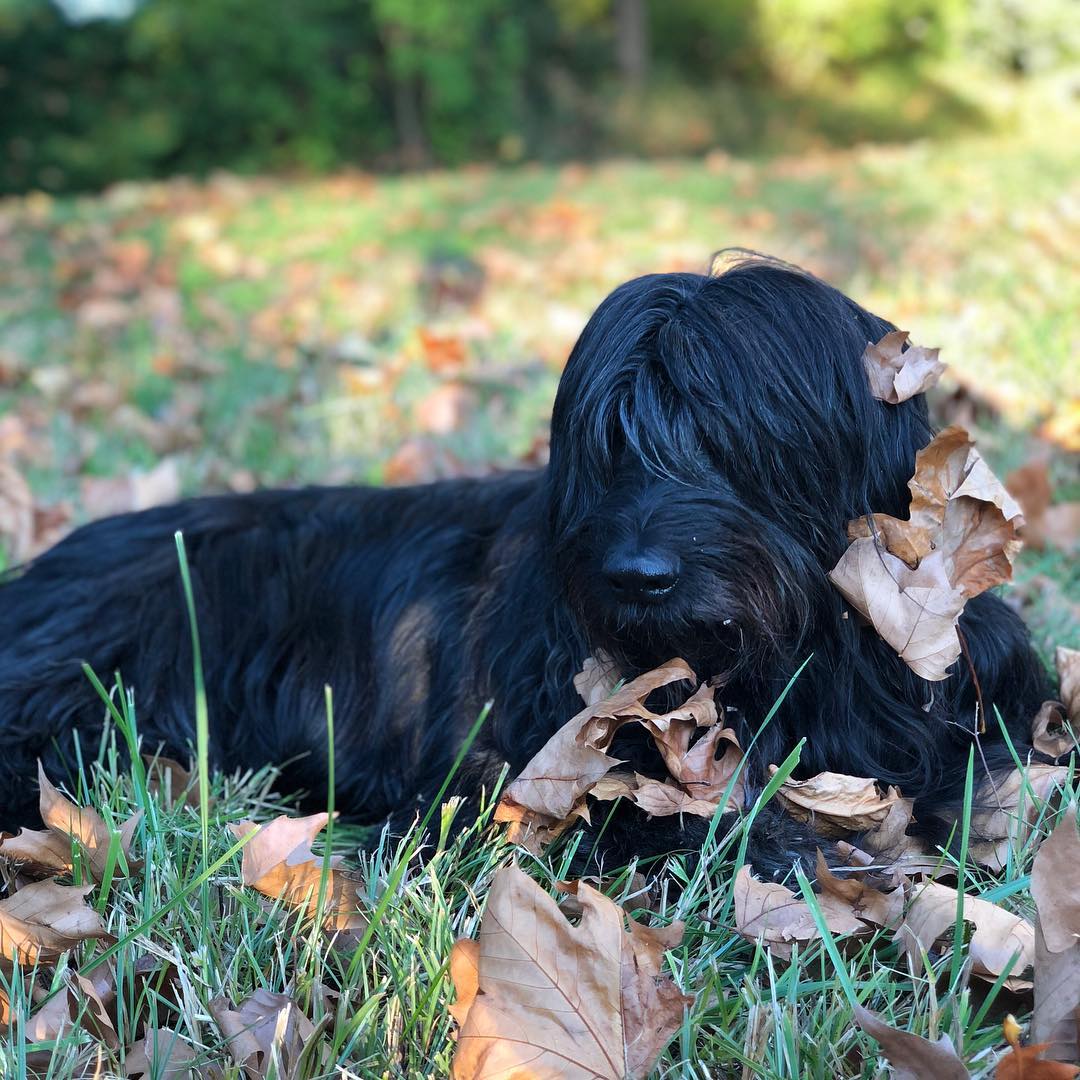
Most of the ailments that fall on briards are due to heredity. These include hip dysplasia, progressive retinal atrophy, night blindness, autoimmune thyroiditis, cancer, von Willebrand-Diana disease. The tendency to volvulus in briards is also genetic. Usually, animals suffering from this disease are shortness of breath, often regurgitate and experience an unreasonable urge to vomit. Less commonly, briards are diagnosed with allergies, which can occur to insect bites or food.
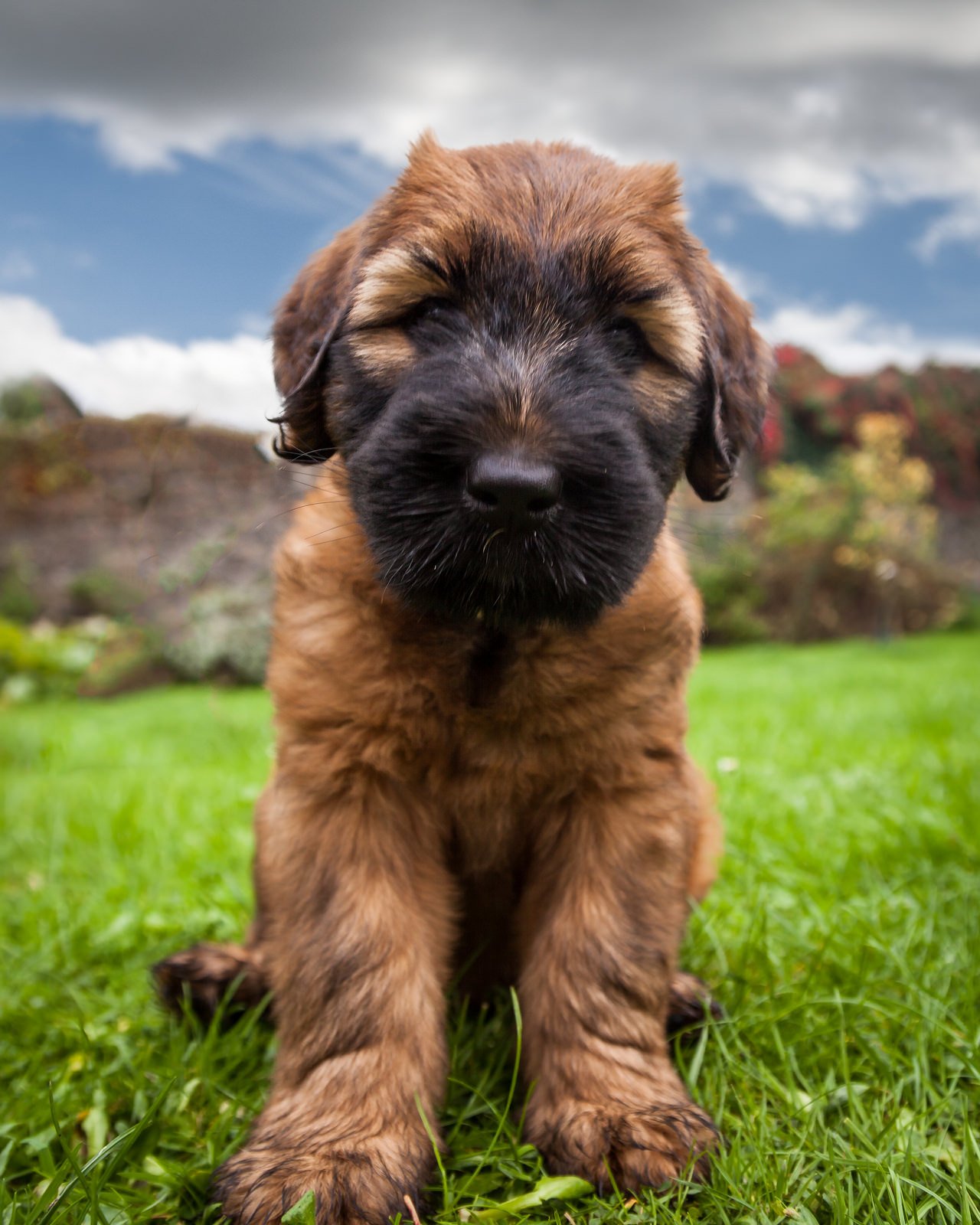
How to choose a puppy?
- Check that the puppy has two dewclaws on each of its hind legs.
- Do not be tempted to choose the largest and fattest baby in the litter, most likely, having matured, he will not fit into the parameters of the standard for height.
- The most trustworthy are nurseries and breeders who check their breeding stock for hip dysplasia. After being examined by a radiologist, prospective producers of offspring should receive an A or B mark.
- Typically, briars of the breeder class pass the IPO-1 standards. If the puppy’s parents were able to score at least 17 points out of 20 possible in the IPO trials, their offspring is considered promising.
- In the first months of life, puppies look like mongrels and very little resemble real briards. Do not be confused by this. As the shaggy lumps grow older, their appearance will change significantly.
- The appearance of the mother and father of puppies plays an important role, so focus on the quality and density of their coat, which babies will inherit in 99 cases out of 100.
- Choose neat, cheerful puppies, with no signs of umbilical hernia and no traces of diarrhea under the tail.

